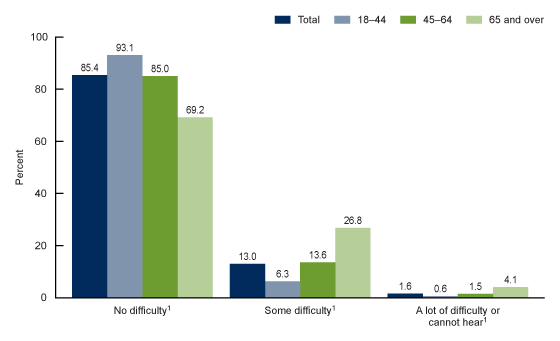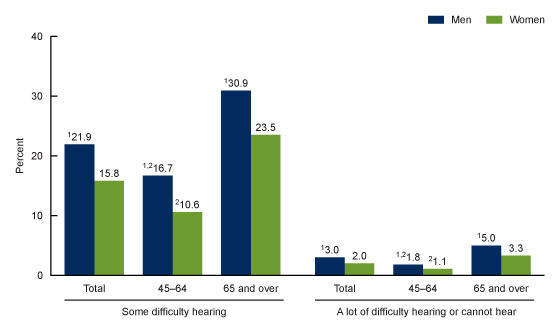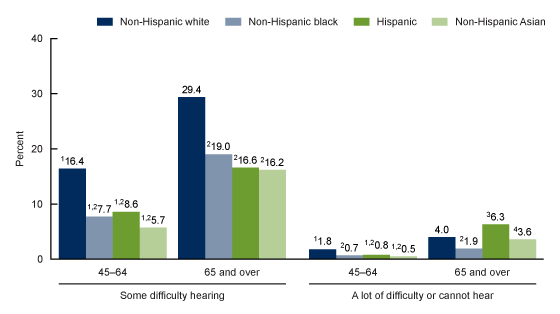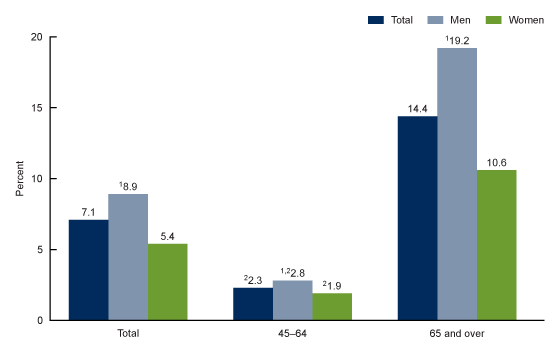Hearing Difficulties Among Adults: United States, 2019
NCHS Data Brief No. 414, July 2021
PDF Version (421 KB)
Jennifer H. Madans, Ph.D., Julie D. Weeks, Ph.D., and Nazik Elgaddal, M.S.
- Key findings
- In 2019, the percentage of adults with hearing difficulties, even when using a hearing aid, increased with age.
- Among adults aged 45 and over, hearing difficulties increased with age among men and women.
- Difficulty hearing even when using a hearing aid varied by race and Hispanic origin for those 45 and over.
- Men were more likely than women to use a hearing aid among adults aged 45 and over.
- Summary
Data from the National Health Interview Survey
- In 2019, 13.0% of adults aged 18 and over had some difficulty hearing even when using a hearing aid and 1.6% either had a lot of difficulty hearing or could not hear at all, even when using a hearing aid.
- Hearing difficulties increased with age with 26.8% of those aged 65 and over having some difficulty and 4.1% having a lot of difficulty or could not hear at all.
- Among adults aged 45 and over, men were more likely than women to have had some or a lot of difficulty or could not hear at all.
- Non-Hispanic white adults aged 45–64 had higher rates of some difficulty, a lot of difficulty, or being unable to hear at all, compared with other race and Hispanic-origin groups.
- In 2019, 7.1% of adults aged 45 and over used a hearing aid; use was higher among men than women in all age groups.
Difficulty hearing is related to other functional difficulties, such as communication, and can limit participation across a range of activities including employment, education, and civic activities. While hearing loss can occur at any age, it increases with age (1,2) and has been shown to be associated with cognitive and functional decline in older adults (3–6). This report presents difficulties with hearing even when using a hearing aid among U.S. adults aged 18 and over by level of difficulty and age, sex, and race and Hispanic origin. It also presents estimates of the prevalence of hearing aid use among adults aged 45 and over to focus on the age group with higher rates of hearing difficulties.
Keywords: hearing aids, race and Hispanic origin, sex, National Health Interview Survey (NHIS)
In 2019, the percentage of adults with hearing difficulties, even when using a hearing aid, increased with age.
- Among adults 18 and over, 13.0% had some difficulty hearing and 1.6% either had a lot of difficulty hearing or could not hear at all even when using a hearing aid (Figure 1).
- The percentage having some difficulty hearing increased with age among adults, from 6.3% among those aged 18–44, 13.6% among those aged 45–64, and 26.8% among those aged 65 and over.
- Having a lot of difficulty hearing or being unable to hear at all also increased with age from 0.6% among those aged 18–44, 1.5% among those aged 45–64, and 4.1% among those aged 65 and over.
Figure 1. Percentage of adults aged 18 and over with difficulty hearing even when using a hearing aid, by age group: United States, 2019

1Significant quadratic trend by age (p < 0.05).
NOTES: Hearing limitation is based on responses to the survey question, “Do you have difficulty hearing, even when using a hearing aid? Would you say no difficulty, some difficulty, a lot of difficulty, or you cannot do this at all?” Estimates are based on household interviews of a sample of the U.S. civilian noninstitutionalized population. Access data table for Figure 1.
SOURCE: National Center for Health Statistics, National Health Interview Survey, 2019.
Among adults aged 45 and over, hearing difficulties increased with age among men and women.
- 16.7% of men and 10.6% of women aged 45–64 had some difficulty hearing even when using a hearing aid, increasing to 30.9% of men and 23.5% of women aged 65 and over (Figure 2).
- 1.8% of men and 1.1% of women aged 45–64 had a lot of difficulty hearing or could not hear at all even when using a hearing aid, which increased to 5.0% of men and 3.3% of women aged 65 and over.
- Having some difficulty, or a lot of difficulty or being unable to hear at all was higher among men than women in both age groups.
Figure 2. Percentage of adults aged 45 and over with difficulty hearing even when using a hearing aid, by sex and age group: United States, 2019

1Significantly different from women p < 0.05.
2Significantly different from age group 65 and over p < 0.05.
NOTES: Hearing limitation is based on responses to the survey question, “Do you have difficulty hearing, even when using a hearing aid? Would you say no difficulty, some difficulty, a lot of difficulty, or you cannot do this at all?” Estimates are based on household interviews of a sample of the U.S. civilian noninstitutionalized population. Access data table for Figure 2.
SOURCE: National Center for Health Statistics, National Health Interview Survey, 2019.
Difficulty hearing even when using a hearing aid varied by race and Hispanic origin for those 45 and over.
- Non-Hispanic white adults had higher percentages of some difficulty hearing even when using a hearing aid among those aged 45–64 (16.4%) and 65 and over (29.4%) than did non-Hispanic black adults (45–64: 7.7%, 65 and over: 19.0%); Hispanic adults (45–64: 8.6%, 65 and over: 16.6%); and non-Hispanic Asian adults (45–64: 5.7%, 65 and over: 16.2% ) (Figure 3).
- Among adults aged 45–64, having a lot of difficulty hearing or being unable to hear at all even when using a hearing aid was more likely among non-Hispanic white adults (1.8%) than non-Hispanic black adults (0.7%), Hispanic adults (0.8%), and non-Hispanic Asian adults (0.5%).
- Hispanic adults aged 65 and over had a higher percentage (6.3%) of having a lot of difficulty hearing or being unable to hear at all even when using a hearing aid compared with non-Hispanic white adults (4.0%), non-Hispanic black adults (1.9%), and non-Hispanic Asian adults (3.6%); although the observed differences between non-Hispanic white and non-Hispanic Asian adults were not significant.
- Percentages for those having some difficulty, a lot of difficulty or being unable to hear at all even when using a hearing aid increased with age for all race and Hispanic-origin groups, although the observed increase among non-Hispanic black adults was not significant.
Figure 3. Percentage of adults aged 45 and over with difficulty hearing even when using a hearing aid, by age group and race and Hispanic origin: United States, 2019

1Significantly different from age group 65 and over (p < 0.05).
2Significantly different from non-Hispanic white (p < 0.05).
3Significantly different from non-Hispanic black (p < 0.05).
4Relative confidence interval width is greater than 130% (actual value = 182%).
NOTES: Hearing limitation is based on responses to the survey question, “Do you have difficulty hearing, even when using a hearing aid? Would you say no difficulty, some difficulty, a lot of difficulty, or you cannot do this at all?” Estimates are based on household interviews of a sample of the U.S. civilian noninstitutionalized population. Access data table for Figure 3.
SOURCE: National Center for Health Statistics, National Health Interview Survey, 2019.
Men were more likely than women to use a hearing aid among adults aged 45 and over.
- 7.1% of the population aged 45 and over used a hearing aid: 8.9% of men and 5.4% of women (Figure 4).
- Hearing aid use increased with age from 2.3% among those aged 45–64 to 14.4% of those aged 65 and over.
- Hearing aid use was higher among men than women among those aged 45 and over. Among those aged 45–64, 2.8% of men and 1.9% of women used a hearing aid. Among those aged 65 and over, 19.2% of men and 10.6% of women used a hearing aid.
Figure 4. Percentage of adults aged 45 and over who used a hearing aid, by sex and age group: United States, 2019

1Significantly different from women (p < 0.05).
2Significantly different from age group 65 and over (p < 0.05).
NOTES: Hearing limitation is based on responses to the survey question, “Do you use a hearing aid?” Estimates are based on household interviews of a sample of the U.S. civilian noninstitutionalized population. Access data table for Figure 4.
SOURCE: National Center for Health Statistics, National Health Interview Survey, 2019.
Summary
In 2019, 13.0% of adults aged 18 and over had some difficulty hearing even when using a hearing aid, and another 1.6% either had a lot of difficulty hearing or could not hear at all. Hearing difficulties even when using a hearing aid increased with age overall, for men and women, and for non-Hispanic white, non-Hispanic black, non-Hispanic Asian and Hispanic adults, although the increase for non-Hispanic black adults was not significant. Non-Hispanic white adults aged 45–64 had higher rates of some difficulty, a lot of difficulty hearing or being unable to hear at all even when using a hearing aid than other race-Hispanic-origin groups. Among those 65 and over, non-Hispanic white adults were more likely to have some difficulty hearing, whereas Hispanic adults were more likely to have a lot of difficulty or being unable to hear at all even when using a hearing aid (although only the comparison with non-Hispanic black adults was significant). In 2019, 7.1% of adults aged 45 and over used a hearing aid, with use increasing with age and higher among men than women in all age groups.
Difficulty hearing can have major impacts on an individual’s ability to fully participate in society and can adversely affect quality of life (7). The findings presented in this Data Brief are for hearing difficulties when using a hearing aid. Estimates of hearing difficulties without hearing aids, if they are used, would be higher. Advancements in hearing aid technology have resulted in improvements in hearing ability with the use of these aids but, as shown in this report, hearing difficulties remain even when hearing aids are used.
Definitions
Hearing difficulty: Based on responses to the survey question, “Do you have difficulty hearing, even when using a hearing aid? Would you say no difficulty, some difficulty, a lot of difficulty, or you cannot do this at all?”
Race and Hispanic origin: Adults categorized as Hispanic may be of any race or combination of races. Those categorized as non-Hispanic white or non-Hispanic black indicated one race only. Estimates for non-Hispanic adults of races other than white only or black only, or of multiple races, are not shown.
Data source and methods
Data from the redesigned 2019 National Health Interview Survey (NHIS) were used for this analysis. NHIS is a nationally representative household survey of the U.S. civilian noninstitutionalized population. It is conducted continuously throughout the year by the National Center for Health Statistics (NCHS). Interviews are conducted in respondents’ homes, but follow-ups to complete interviews may be conducted over the telephone. Data for this analysis are from the hearing section of the Sample Adult interview (n = 31,887). For more information about NHIS, visit: https://www.cdc.gov/nchs/nhis.htm.
Point estimates and corresponding confidence intervals for this analysis were calculated using SAS-callable SUDAAN version 11.0 software (8) to account for the complex sample design of NHIS. Differences between percentages were evaluated using two-sided significance tests at the 0.05 level. Other than where noted, all estimates meet NCHS standards of reliability as specified in “National Center for Health Statistics Data Presentation Standards for Proportions” (9). In this case, the estimate is provided following careful review. While the estimate itself is not stable, significant differences compared with other estimates provide useful information.
About the authors
Jennifer H. Madans is a guest researcher in the NCHS Office of the Director. Julie D. Weeks and Nazik Elgaddal are with the NCHS Division of Analysis and Epidemiology.
References
- Zelaya CE, Lucas JW, Hoffman HJ. Self-reported hearing trouble in adults aged 18 and over: United States, 2014. NCHS Data Brief, no 214. Hyattsville, MD: National Center for Health Statistics. 2015.
- Gorman AM, Lin FR. Prevalence of hearing loss by severity in the United States. Am J Public Health 106(10):1820–22. 2016.
- Loughrey DG, Kelly ME, Kelley GA, Brennan S, Lawlor BA. Association of age-related hearing loss with cognitive function, cognitive impairment, and dementia: A systematic review and meta-analysis. JAMA Otolaryngol Head Neck Surg 144(2):115–26. 2018.
- Deal JA, Betz J, Yaffe K, Harris T, Purchase-Helzner E, Satterfield S, et al. Hearing impairment and incident dementia and cognitive decline in older adults: The health ABC study. J Gerontol A Biol Sci Med Sci 72(5):703–9. 2017.
- Lin FR, Yaffe K, Xia J, Xue QL, Harris TB, Purchase-Helzner E, et al. Hearing loss and cognitive decline in older adults. JAMA Intern Med 173(4):293–9. 2013.
- Chen DS, Betz J, Yaffe K, Ayonayon HN, Kritchevsky S, Martin KR, et al. Association of hearing impairments with declines in physical functioning and the risk of disability in older adults. J Gerontol A Biol Sci Med Sci 70(5):654–61. 2015.
- Punch JL, Hitt R, Smith SW. Hearing loss and quality of life. J Commun Disord 78: 33–45. 2019.
- RTI International. SUDAAN (Release 11.0.3) [computer software]. 2018.
- Parker JD, Talih M, Malec DJ, Beresovsky V, Carroll M, Gonzalez JF Jr, et al. National Center for Health Statistics data presentation standards for proportions. National Center for Health Statistics. Vital Health Stat 2(175). 2017.
Suggested citation
Madans JH, Weeks JD, Elgaddal N. Hearing difficulties among adults: United States, 2019. NCHS Data Brief, no 414. Hyattsville, MD: National Center for Health Statistics. 2021. DOI: https://dx.doi.org/10.15620/cdc:107540.
Copyright information
All material appearing in this report is in the public domain and may be reproduced or copied without permission; citation as to source, however, is appreciated.
National Center for Health Statistics
Brian C. Moyer, Ph.D., Director
Amy M. Branum, Ph.D., Associate Director for Science
Division of Analysis and Epidemiology
Irma E. Arispe, Ph.D., Director
Kevin C. Heslin, Ph.D., Associate Director for Science